CinchonaQuinine tree, Peruvian bark, Jesuits bark |

|
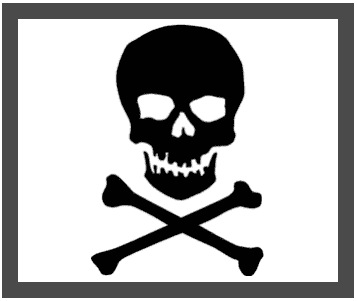
|
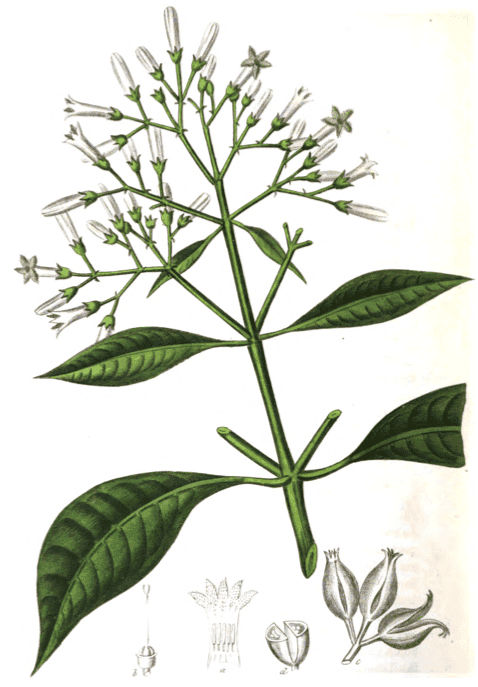
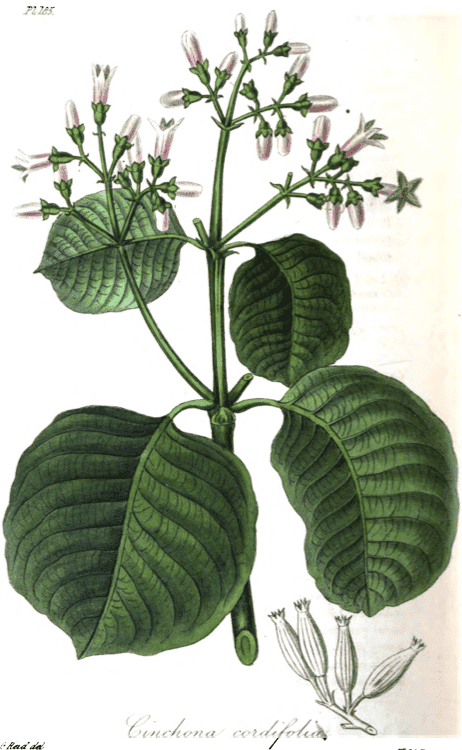
|
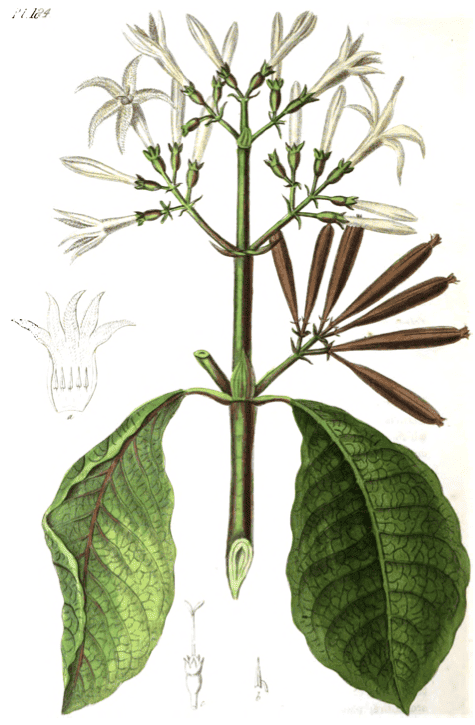
|
Bottom Left: C. cordifolia, Bottom Right: C. oblongifolia
Medical Botany, Stephenson and Churchill, 1836
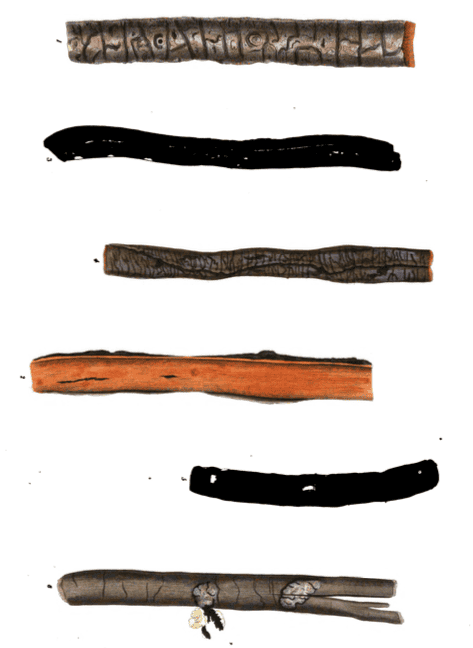 Varieties of Pale Cinchona bark
Varieties of Pale Cinchona barkHortus Medicus, Graves, 1834
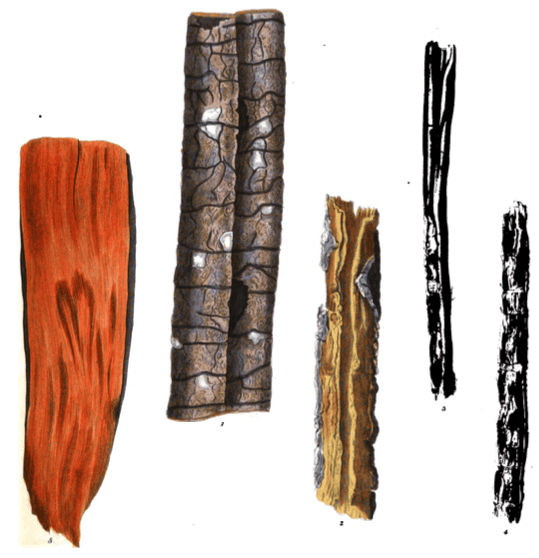
|
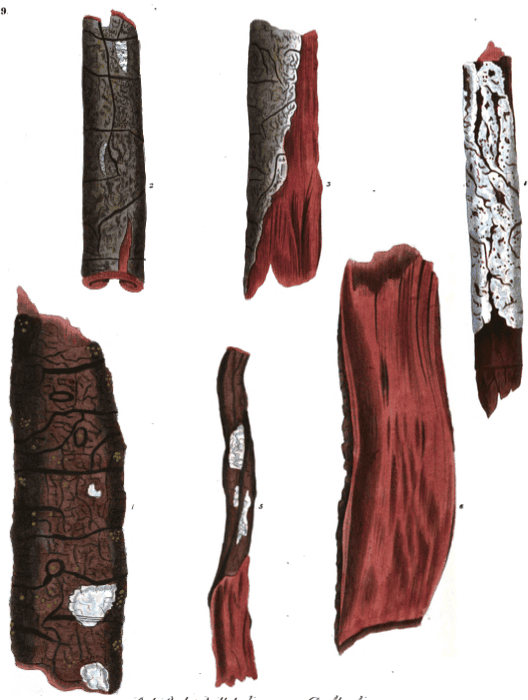
|
Hortus Medicus, Graves, 1834
Botanical name:
Cinchona spp. particularly C. officinalis (syn. C. robusta), ‘Pale’ Cinchona
Three main types were recognised: Pale (or Crown), Red and Yellow, the official being Pale, but all are used synonymously.
Related species:
Redbark, Red Cinchona: C. pubescens (syn. C. succirubra)
Yellowbark, Yellow Cinchona: C. callisaya
Other species include C. flava, C. pallida, C. cordifolia, C. oblongifolia
Parts used:
Bark
Temperature & Taste:
Cool, dry. Bitter
Uses:
1. Clears Wind and Heat:
-Intermittent Fevers, Malarial Fever; used between the febrile attacks
-Influenza, Thyphus, Scarlet Fever
-acute Cough, Whooping Cough
-used for ‘half-exterior, half-interior’ conditions where a pathogen has penetrated the surface of the body but has not yet invaded the interior, marked by Fever and Chills
2. Stimulates and Benefits Digestion:
-Debility or Wasting in diseases of a chronic nature; has been used for Anemia and Cachexia
-chronic indigestion and nervous diseases
-strengthens the nerves and digestion and induces a healthy tone throughout the system.
-small doses; this function is from its bitter effect
3. Clears Heat and Damp, Resolves Masses:
-chronic diarrhea, Jaundice, Edema
-Scrofula, Tumors, Cancer (incl. that of the Breast, Liver and Spleen)
-Protracted discharges from Abscesses and Wounds
-has also been used for Night Sweats
4. Promotes Menstruation:
-Amenorrhea
-early American practitioners sometimes regarded it as a female tonic
5. Kills Worms:
6. Used for Alcoholism:
-has a reputation for aiding in the cure of Alcoholism. A spirit of the Bark was given, and when the patient was willing to be cured, a gradual disgust for all liquor was often achieved.
7. Externally:
-tincture is applied to the scalp for baldness and thinning hair
-applied to Gangrene
Dose:
Powder: 300mg–2, or 3 grams
Cinchona Extract (1:1): 0.3–1ml.;
Cinchona Tincture (1:5): 2–4mls.
In Britain it is a scheduled herb with a maximum dose of 250mg, and a maximum daily dose of 750mg.
Traditional dose of the Powder: 1–3 grams of the powder (up to 6 grams).
In the treatment of Intermittent Fevers, 1–2 drams (3–6 grams) (by some up to an ounce) per day was used. Smaller doses given every 3 or 4 hours are better than single large doses.
An infusion of 1 oz. to 1 pound of Red Wine was given in 4–6 oz. doses
Substitutes:
1. In India, Ajuga bracetosa is used as a substitute.
2. Artemisia vulgaris var. nilagirica (syn. A. nilagirica) is regarded as an inferior substitute.
3. Horse Chestnut bark
4. European Physicians had several compounds to emulate Cinchona:
i. One example: Horse Chestnut bark, Willow bark (of each ½ oz.), Gentian, Calamus, Avens root (of each 2 drams) (Niemann, Hufeland)
ii. Gentian (½ oz.), Bistort, Peony (2 drams each). Used in place of Cinchona, and when that has failed. (Ratier)
5. Avens was substituted sometimes and was said to be effective in cases where Cinchona has failed.
Correctives:
Usually combined with Cinnamon or Ginger
Main Combinations:
FEVER:
1. Fevers; Intermittent or Continual:
i. Cinchona with Camomile
ii. Cinchona with Barberry
iii. Cinchona with Contrayerva
iv. Cinchona with Camphor
v. Cinchona with Ginger
vi. Cinchona with Rhubarb
vii. Cinchona with Hiera Picra (A Treatise on Foreign Drugs, Geoffroy and Thicknesse, 1749)
viii. Cinchona with Diascordium
ix. Cinchona with Wormwood, Fumitory
x. Cinchona with Elder berry, Camomile, Centaury
xi. Cinchona (1 oz.), Gentian, Bitter Orange peel (2 drams), Sal Ammoniac, rhubarb (1 dram) (Jadelot’s Febrifuge Powder)
xii. Cinchona with Oyster shell and Potassium Nitrate
xiii. Cinchona with Potassium Sulphate
xiv. Cinchona (3 drams), Cream of Tartar (15 grains), Potassium Nitrate (10 grains)
xv. Cinchona powder (1 scruple), Cinnamon powder (2 scruples), Alum powder (2 drams). Mix. (Astringent Anti-Febrile Powder, from Pharmacopoeia Pauperum Hamburgensis, 1804)
2. Intermittent Fevers:
i. Cinchona with Wormwood
ii. Cinchona (1 oz.), Valerian (half ounce), Cinnamon (1 scruple), form an Electuary with Honey.
iii. Intermittent Fever with spitting of purulent sputum, Cinchona with Ground Ivy, Bugle, Sanicle, Ladies Mantle, Wintergreen, Coltsfoot (A Treatise on Foreign Drugs, Geoffroy and Thicknesse, 1749)
iv. Cinchona, Cinnamon, Star Thistle, Camomile, Wild Valerian, Wormwood, Lesser Centaury, form an Electuary with Honey.
v. Cinchona, Serpentaria, Cinnamon, Camphor, with Syrup of Wormwood form an Electuary
vi. Cinchona, Wormwood, Catechu, Lesser Centaury (Formulaire Magistral et Memorial Pharmaceutique, 1823)
vii. Cinchona, Virginian Snake root, Pennyroyal, Camomile, Vervain
3. Typhus Fever, Cinchona, Rosemary, Marjoram, Vervain, Betony, Raspberry leaf
4. Post-Fever Debility, Cinchona with Mugwort
DIGESTION:
5. To strengthen the Stomach, digestive debility:
i. Cinchona with Catechu.
ii. Cinchona with Gentian, Orange peel and Licorice
iii. Cinchona with Calamus and Cinnamon
iv. Cinchona with Calamus, Cinnamon, Orange peel in Port Wine (Tinctura Burgandica, Niemann)
iv. Cinchona with Rhubarb and Arum root (Stomachic Powder, from Pharmacopoeia Suecica, 1817)
6. Chronic Diarrhea: Cinchona, Orange peel (6 drams each), Crab’s Eyes (2 drams), Conserve of Rose and Rosehip (6 drams each), Syrup of Catechu (sufficient). Mix. (Nouveau Formulaire Medicale et Pharmaceutique, 1820)
NERVOUS SYSTEM:
7. Spasms:
i. Cinchona (2 drams), Valerian (1 dram). Divide into equal doses to be taken over 24 hours. (Ratier)
ii. Cinchona, Licorice extract (3 drams each), Valerian (36 grains). Divide into 9 doses. (Niemann)
8. Epilepsy, Hysteria:
i. Cinchona (2 parts), Valerian (1 part), form an Electuary with Syrup of Orange peel (Niemann)
ii. Cinchona (6 drams), Serpentaria (2 drams), form an Electuary with Syrup of Peony. (Pharmacopoeia Hispana, 1798)
iii. Cinchona (1 dram), Valerian (30 grains), Mistletoe (20 grains), Cinnabar (10 grains), form an Electuary with Syrup of Orange peel. Dose: 1 dram morning and evening. (Memorial Pharmaceutique, 1824)
9. Nervous Debility, Cinchona with Valerian
OTHER:
10. Heart debility:
i. with Arrhythmia, Cinchona with Motherwort
ii. with digestive weakness, Cinchona, Hawthorn, Yarrow, Ginger, Licorice
11. As a female tonic, Cinchona with Cinnamon, Soloman’s Seal, Comfrey, Gentian, Camomile (Meyer)
12. Leukorrhea, Cinchona with Rosemary, Rose, Mastic, Catechu, Cinnamon
EXTERNALLY:
13. Gangrene and obstinate Ulcers, Cinchona with Rue and Camphor, powder and apply.
14. Tooth Powders:
i. Cinchona, Red Sandalwood, Alum, Oil of Clove
ii. Cinchona, prepared Coral, Cinnamon
iii. Charcoal, Cinchona, Myrrh
iv. Cinchona, Orris, Sage, Myrrh
Major Formulas:
1. Camphorated Powder of Cinchona:
i. Cinchona (half ounce), Camphor (1 scruple), Gum Arabic (2 drams). Mix and divide into 12 portions.
Cautions:
1. Avoid overdose. From 8–20 grams may be fatal (Duke)
2. Not used during Pregnancy
3. Large doses produce nausea, sometimes vomiting and diarrhea, headache, tinnitus and nervous system disorders.
4. Contraindicated in inflammation or irritation of the system. It is generally not used in Fever, but is administered between attacks of Intermittent Fevers. ‘… many cases of fever occur which are found to be aggravated by the Cinchona, yet afterwards readily yield to the simple bitters.’ (Woodville)
Main Preparations used:
Extract
-
Extra Info
-
History
|
‘The Account we have of its first Discovery is this, Some Trees which bear it being thrown by Wind. or some other Accident, into a Pool of Water, lay there till the Water acquired so bitter a Taste that no Person could drink it. However, one of the neighbouring Inhabitants being seized with a violent Fit of a Fever, and finding no other Water to quench his Thirst, was forced to drink of this; by which he was perfectly cured both of his Fever and Thirst. Upon prevailed up |
on some of his Friends, who were ill of Fevers, to make use of the same Remedy; which accordingly they did, and with equal Success. But the Trees after some Time becoming rotten, and the Water losing its bitter Taste and its Virtue, they made a diligent Search after the Cause of this Bitterness, and antifebrile Quality in the Water; and at length traced it up to the Bark of these Trees. (A Treatise on Foreign Drugs, Geoffroy and Thicknesse, 1749) |
